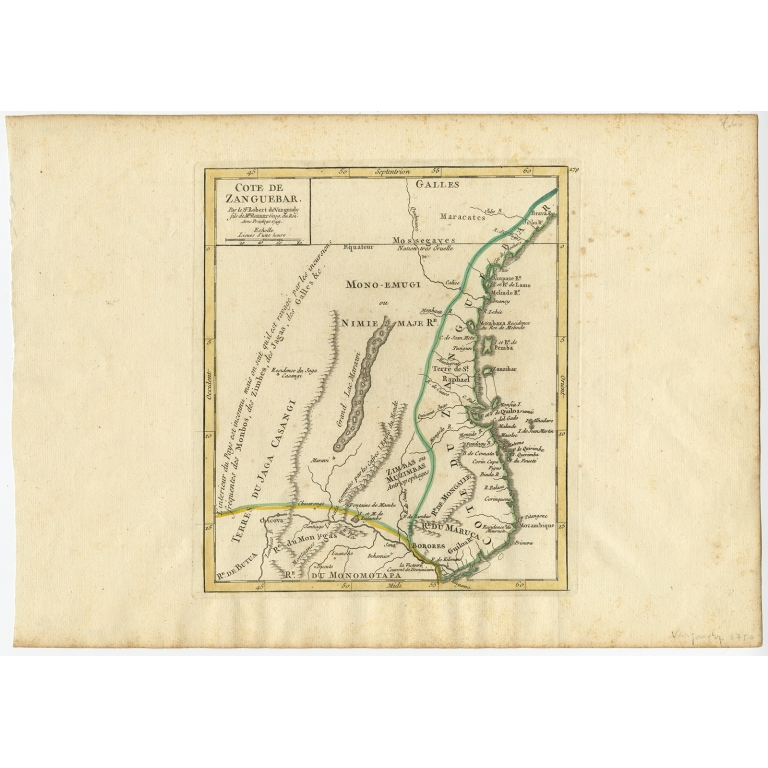FREE
WORLDWIDE
SHIPPING
No products
BL-00011
Antique Map of the Coast of Zanzibar by Vaugondy (1749)
- Condition: Good, general age-related toning. Minor wear. Please study image carefully.
- Date: 1749
- Overall size: 33.5 x 24.1 cm
- Image size: 17.5 x 19.8 cm
Worldwide
shipping

Description: Antique map titled 'Cote de Zanguebar'. Original antique map of Kenya, Tanzania, Mozambique, Malawi and Zanzibar. The map presents the African coast from just north of the Equator to Mozambique and from the 'unknown interior' of the continent to the Indian Ocean. An incomplete, embryonic depiction of Lake Malawi (Grand Lac Marawi) is at the center of the map. Though Lake Malawi had not yet been 'discovered', it had appeared on early maps of Africa, including Emmanuel Bowen's 1747 A New and Accurate Map of Africa. Lake Malawi was not officially discovered until Portuguese trader Candido Jose da Costa Cardoso stumbled upon it in 1849 – one hundred years after Vaugondy's representation here. Vaugondy's and Bowen's inclusion of Lake Malawi is most likely a prescient interpretation of indigenous reports brought to Europe by 17th century Portuguese traders. Its form would be followed by subsequent cartographers well into the mid-19th century when the explorations of John Hanning Speke, David Livingstone, Richard Francis Burton and others would at last yield a detailed study of Africa's interior.
The Zanzibar archipelago, which lies off the coast of Tanzania, is made up of two islands, Unguja (usually referred to as Zanzibar) and Pemba, which is also labeled here. Zanzibar has a long history, and was most likely mentioned in a Greco-Roman text which dates from between the 1st and 3rd centuries AD. In 1749, when Didier Robert de Vaugondy composed this map, Zanzibar was under the control of the Sultanate of Oman. Zanzibar and Pemba became British protectorates in 1890, and remained so until 1963, when it became an independent country within the Commonwealth. In April 1964, the People's Republic of Zanzibar and Pemba merged with Tanganyika to become the United Republic of Tanzania.
Several cities are labeled, including Mombasa (Monbaza), Kenya. Mombasa has a note associated with it, stating that it is the residence of the Roi de Melinde, who appears in Rabelais's work La vie de Gargantua et de Pantagruel. Numerous rivers and tributaries are depicted, including the Zambeze River near the bottom of the map. Different regions of the map are labeled as belonging to a certain tribe. A note is included along the left border which states, 'The interior or the country is unknown, but it is known that it is ravaged by frequent incursions by Monbos, Zimbes, Jagas, Galles, etc' (L'interieur du Pays est inconnu, mais on sait qu'il est ravage par les incursions fréquentes des Monbos, des Zonves, des, Jagas, des Galles, etc.).
This map was published by Gilles Robert de Vaugondy in his 'Atlas Universel, Portatif et Militaire' 1749 edition.
Artists and Engravers: Gilles (1688 - 1766) and Didier (c. 1723 - 1786) Robert de Vaugondy were map publishers, engravers, and cartographers active in Paris during the mid-18th century. The father and son team were the inheritors to the important Sanson cartographic firm whose stock supplied much of their initial material. Graduating from Sanson's map's Gilles, and more particularly Didier, began to produce their own substantial corpus of work. Vaugondys were well respected for the detail and accuracy of their maps in which they made excellent use of the considerable resources available in 18th century Paris to produce the most accurate and fantasy-free maps possible. The Vaugondys compiled each map based upon their own superior geographic knowledge, scholarly research, the journals of contemporary explorers and missionaries, and direct astronomical observation - moreover, unlike many cartographers of this period, they commonly took pains to reference their source material. Nevertheless, even in 18th century Paris geographical knowledge was severely limited - especially regarding those unexplored portions of the world, including the poles, the Pacific northwest of America, and the interior of Africa and South America. In these areas the Vaugondys, like their rivals De L'Isle and Buache, must be considered speculative geographers. Speculative geography was a genre of mapmaking that evolved in Europe, particularly Paris, in the middle to late 18th century. Cartographers in this genre would fill in unknown areas on their maps with speculations based upon their vast knowledge of cartography, personal geographical theories, and often dubious primary source material gathered by explorers and navigators. This approach, which attempted to use the known to validate the unknown, naturally engendered many rivalries. Vaugondy's feuds with other cartographers, most specifically Phillipe Buache, resulted in numerous conflicting papers being presented before the Academie des Sciences, of which both were members. The era of speculatively cartography effectively ended with the late 18th century explorations of Captain Cook, Jean Francois de Galaup de La Perouse, and George Vancouver.



